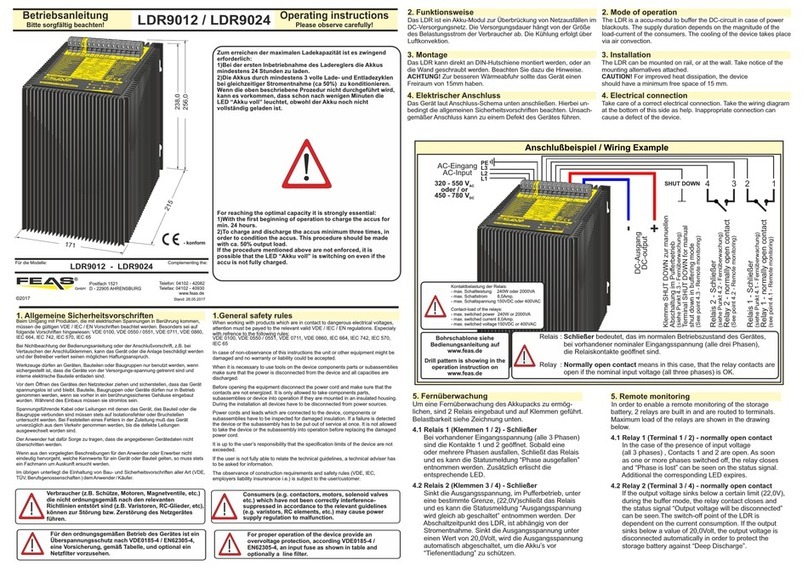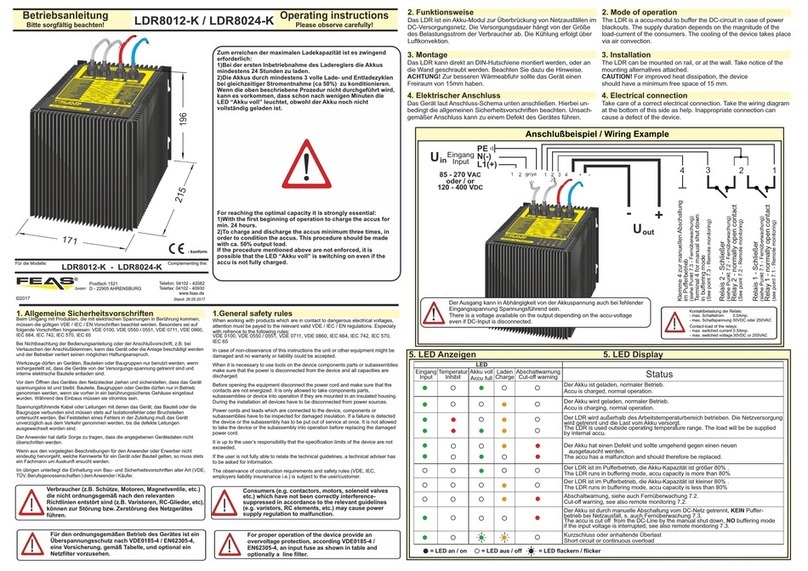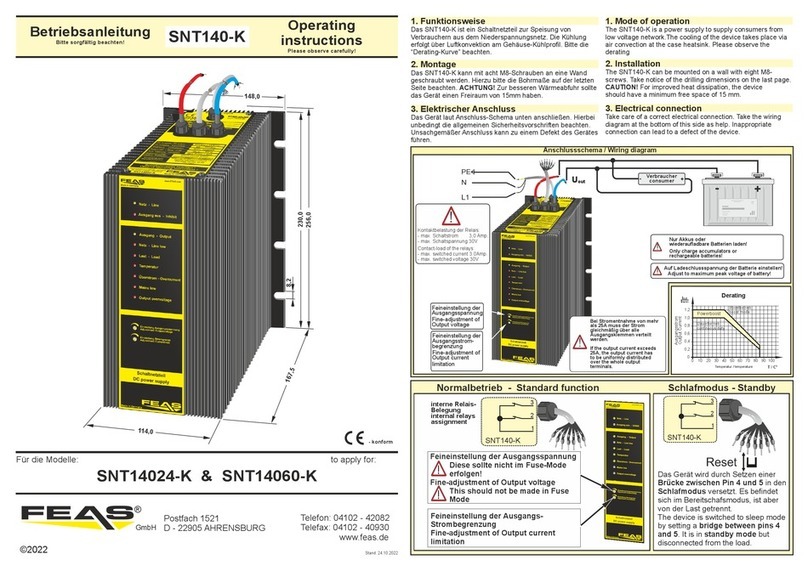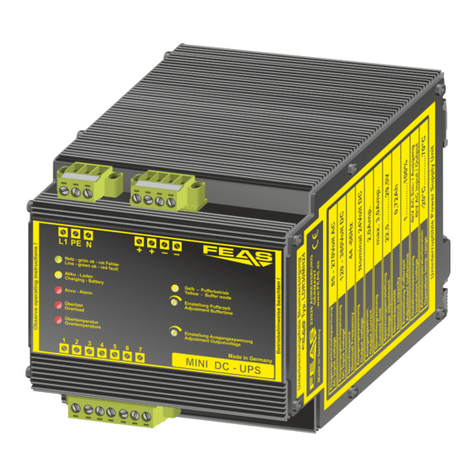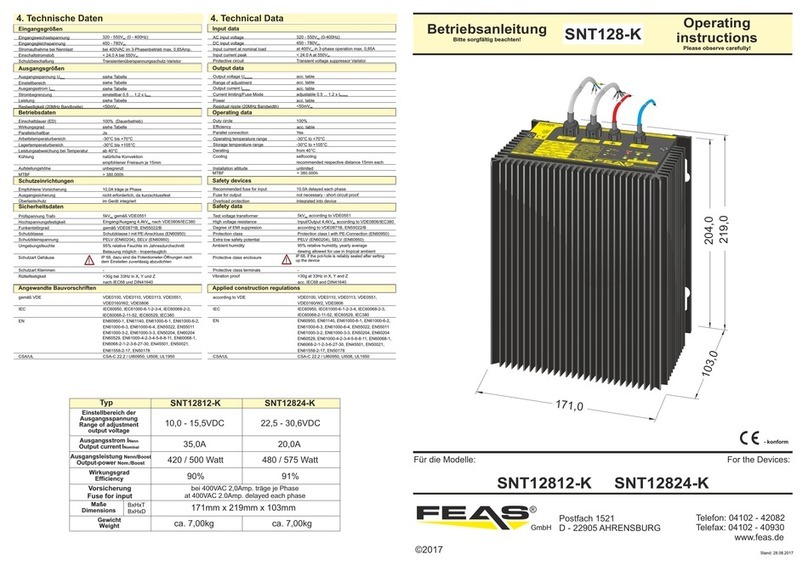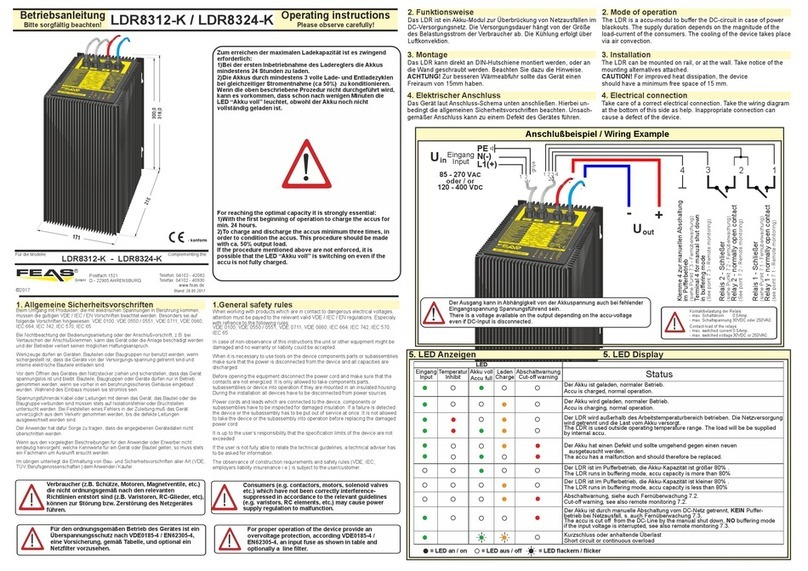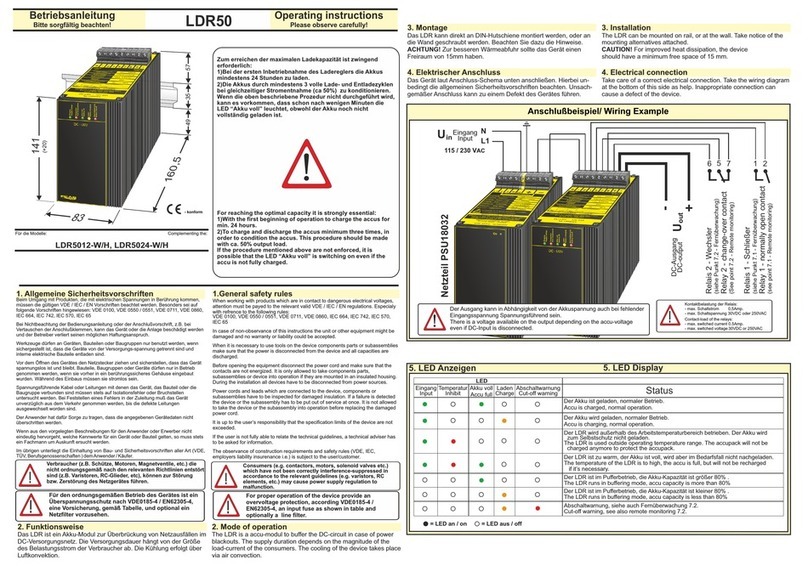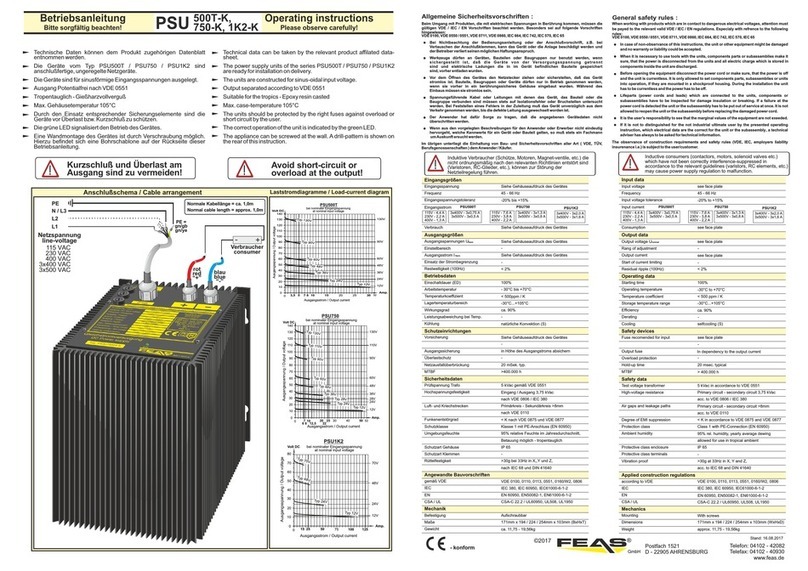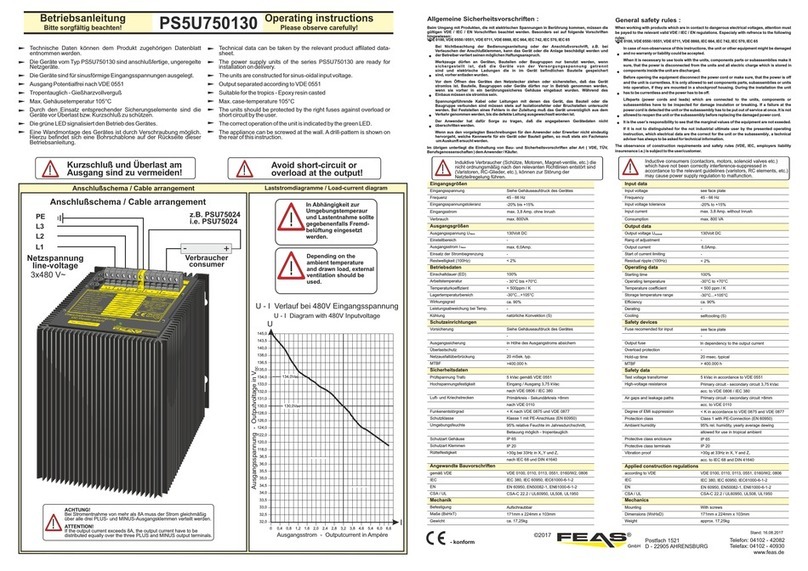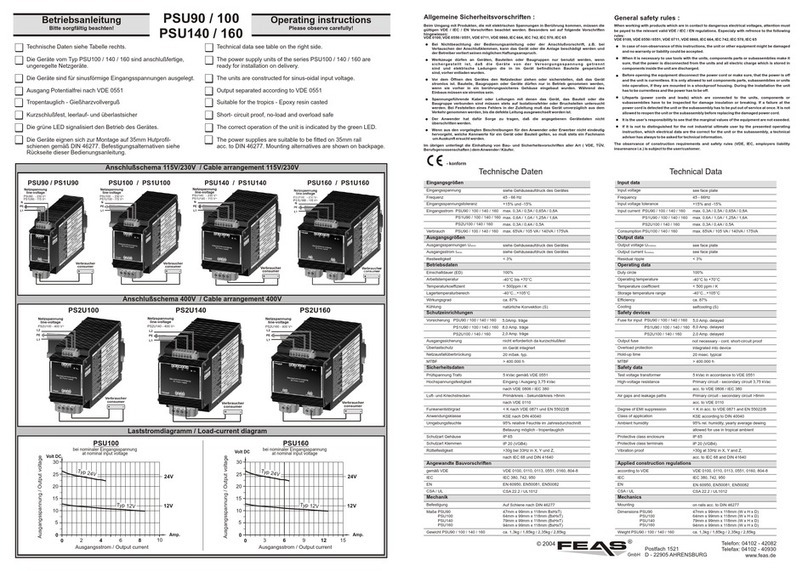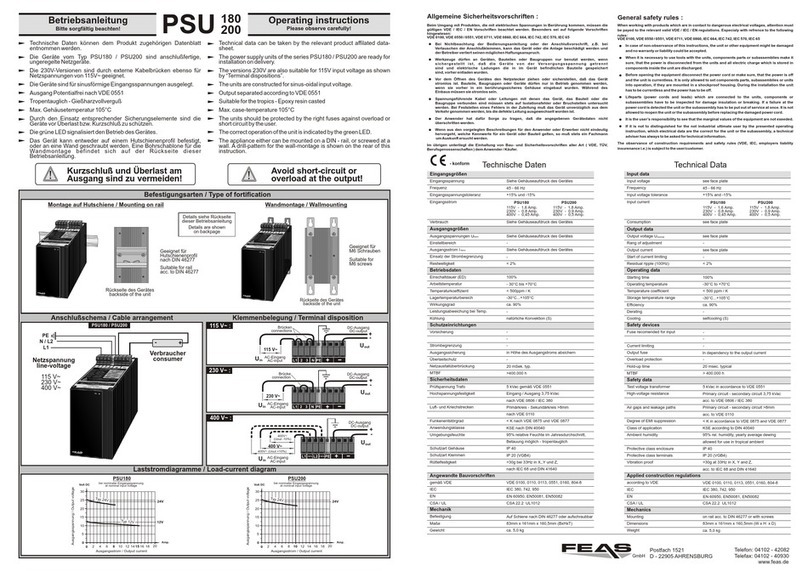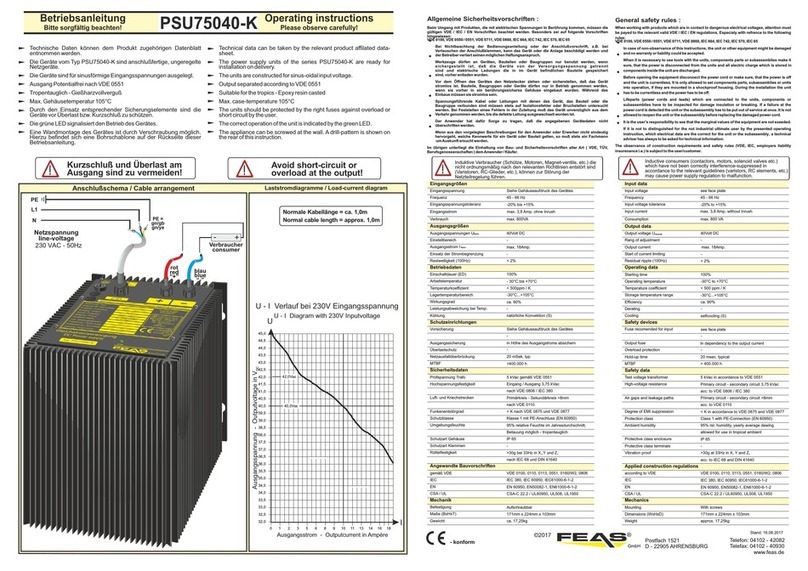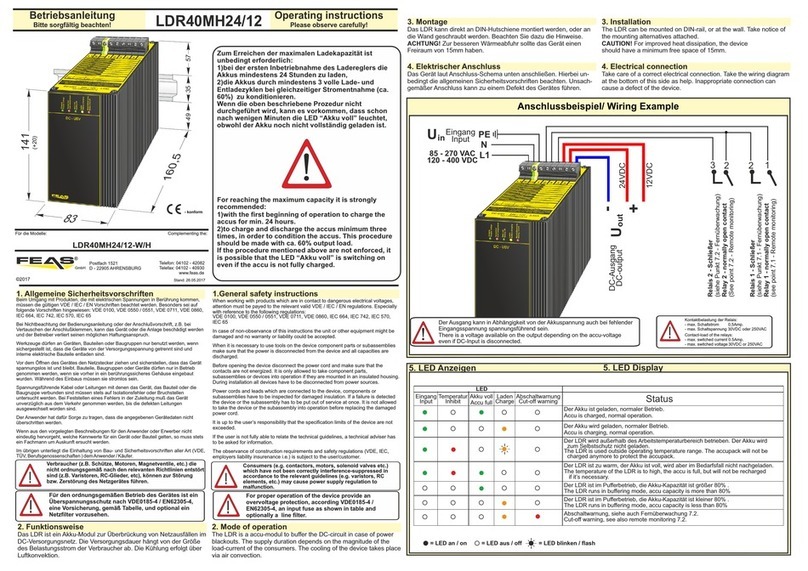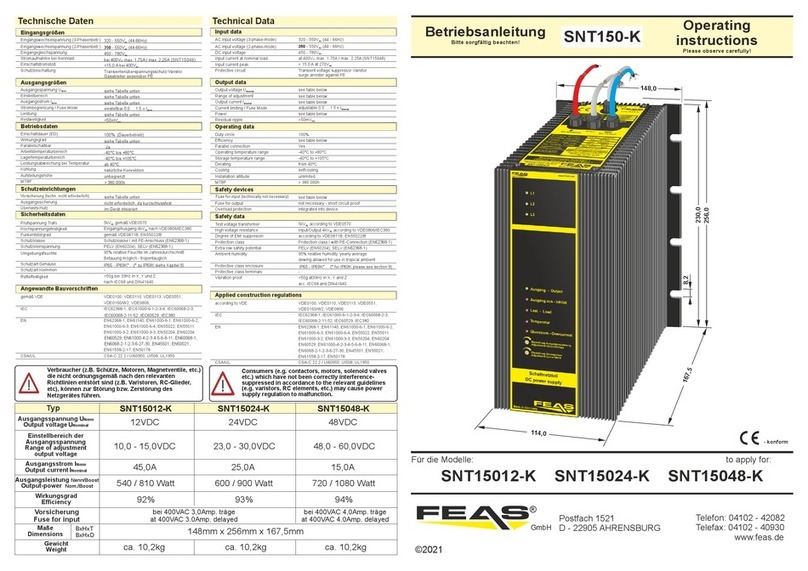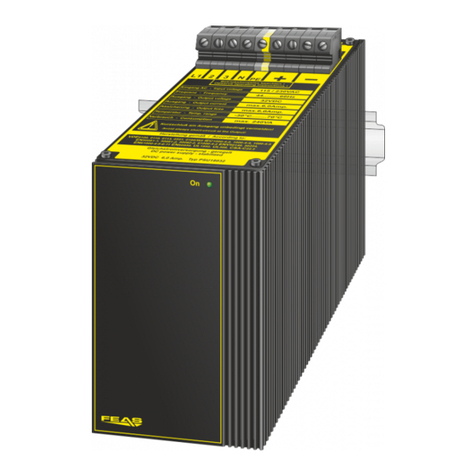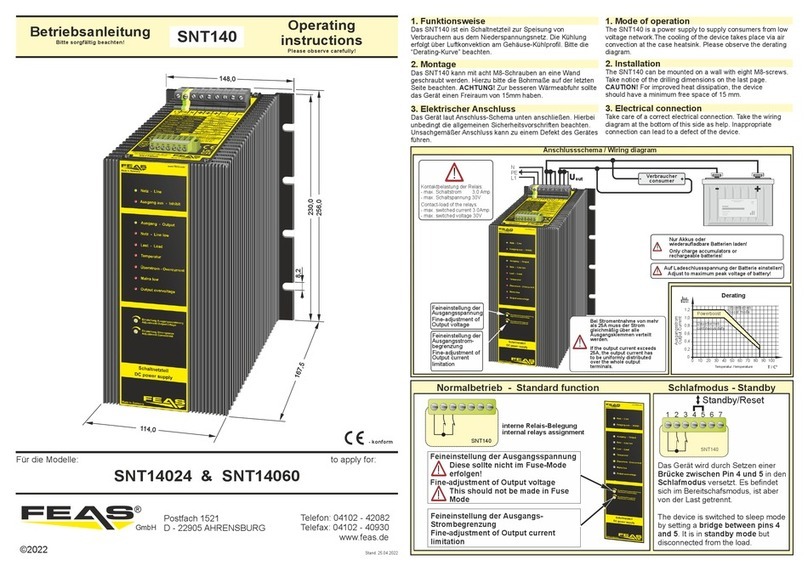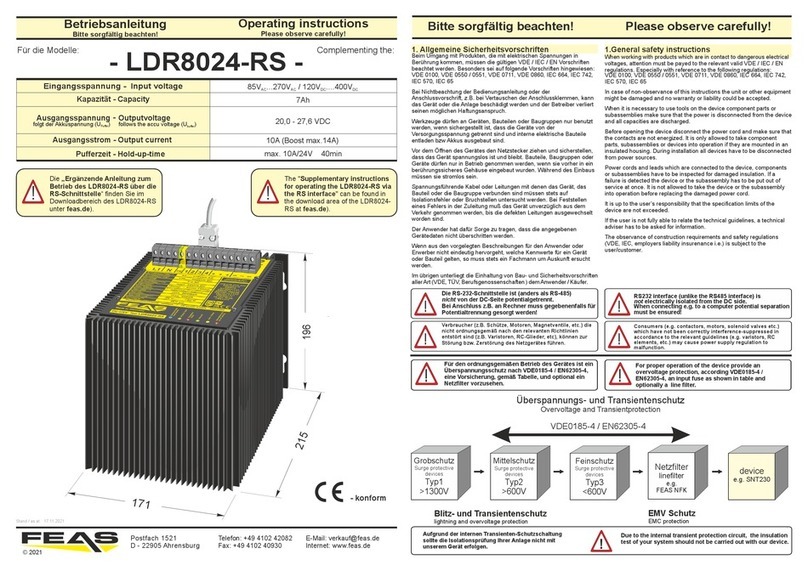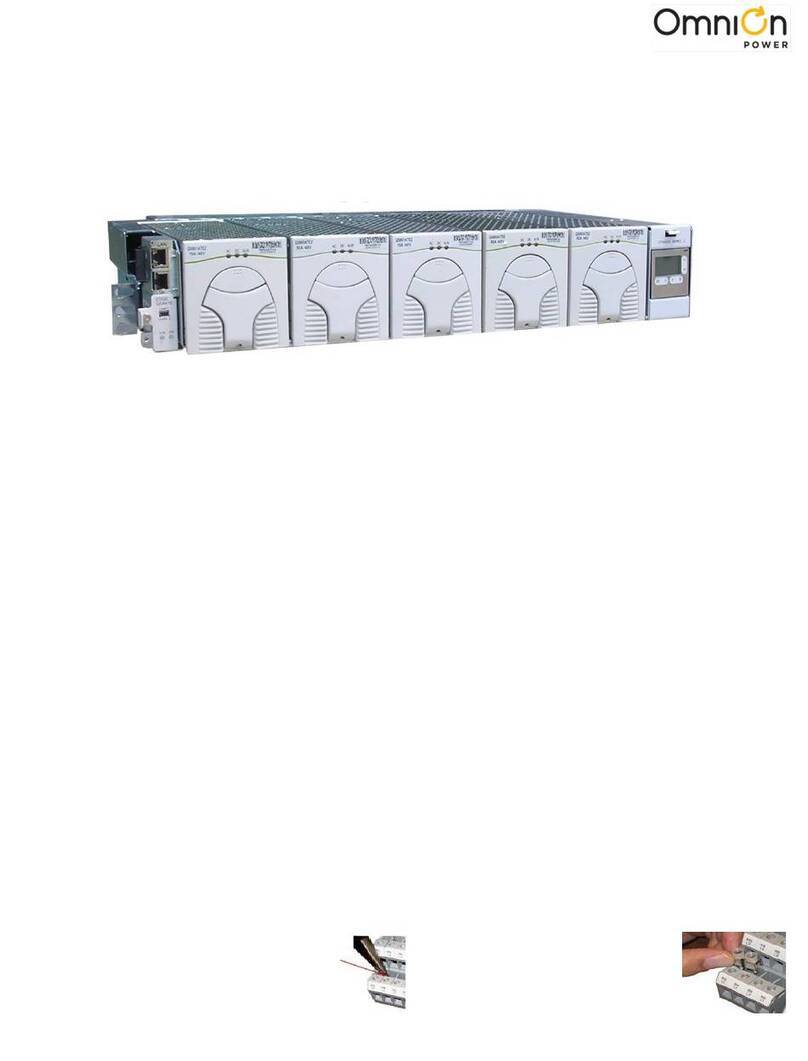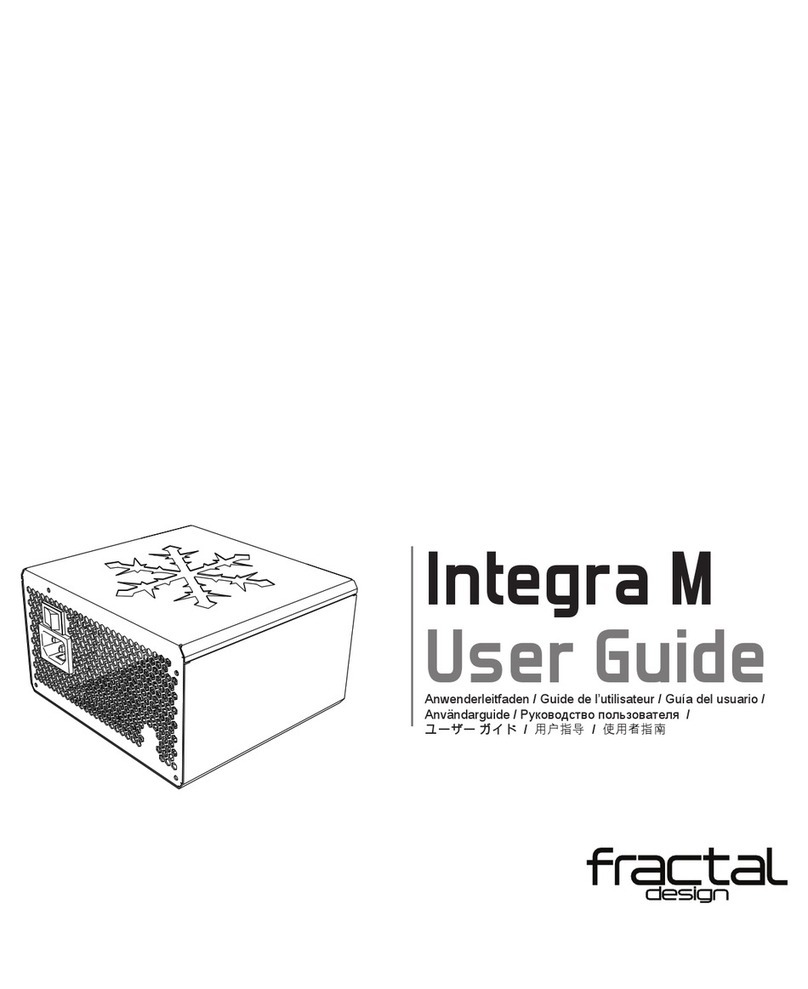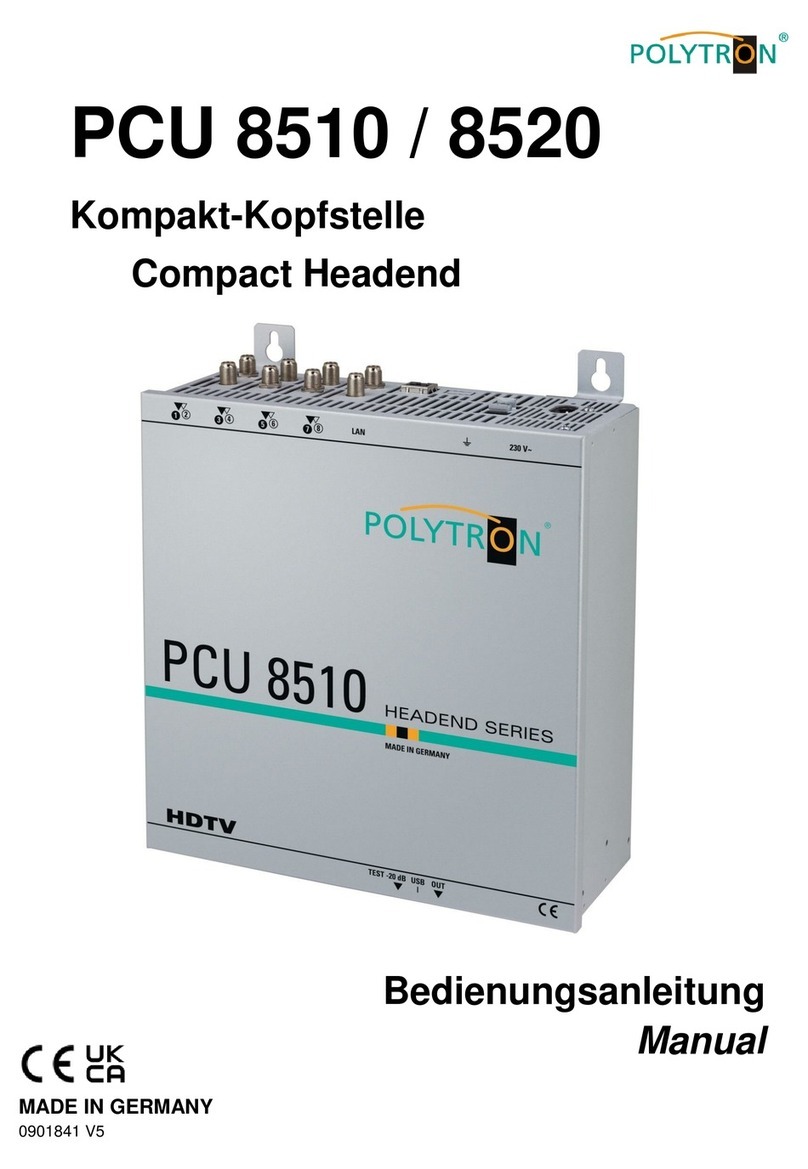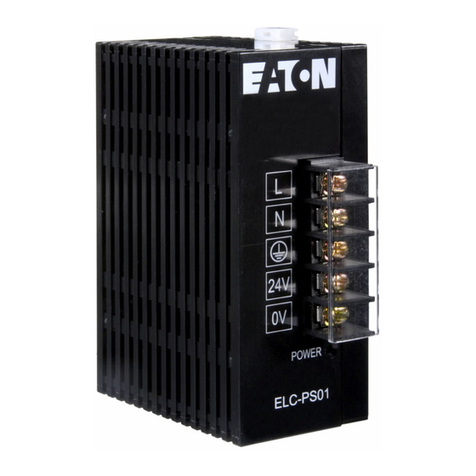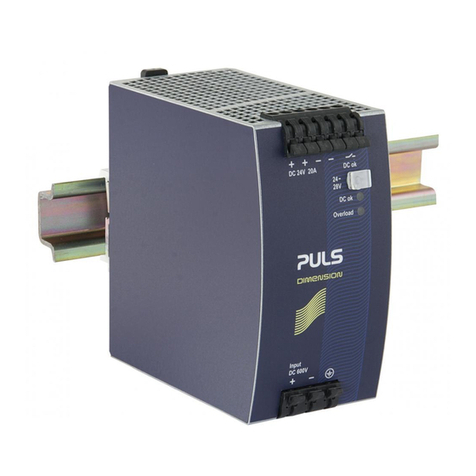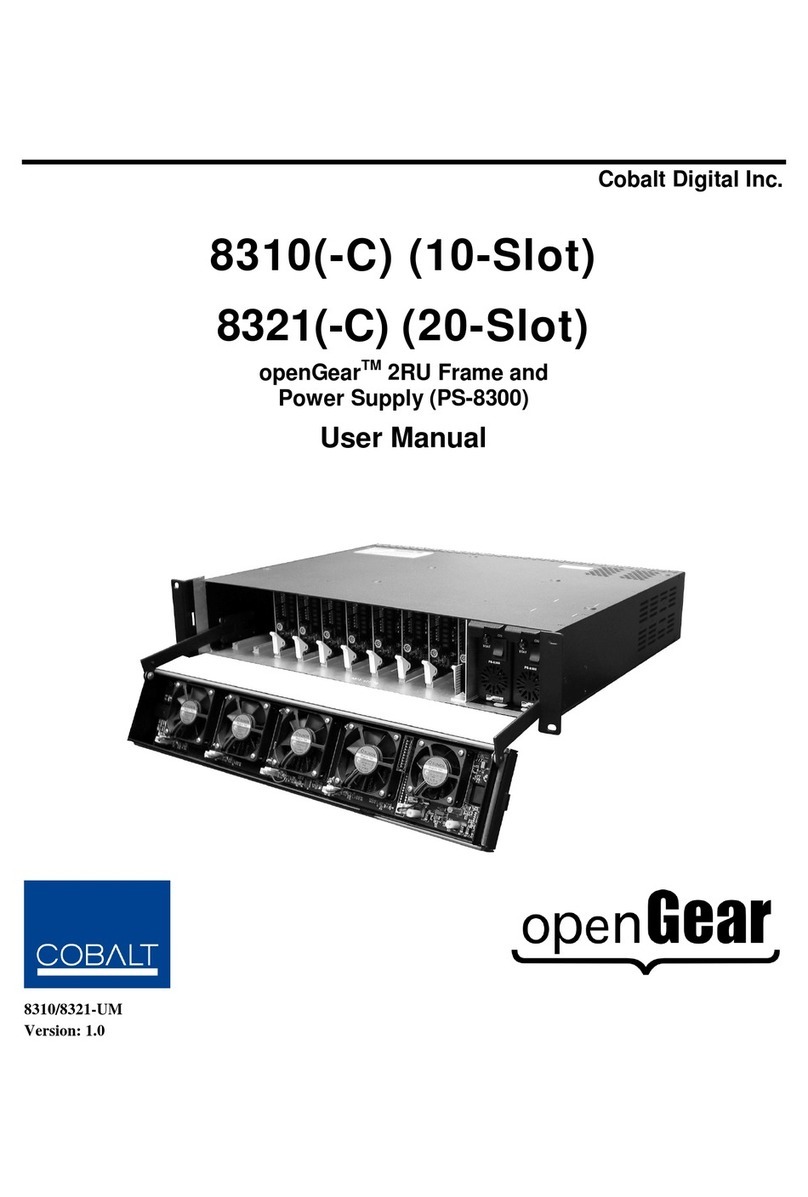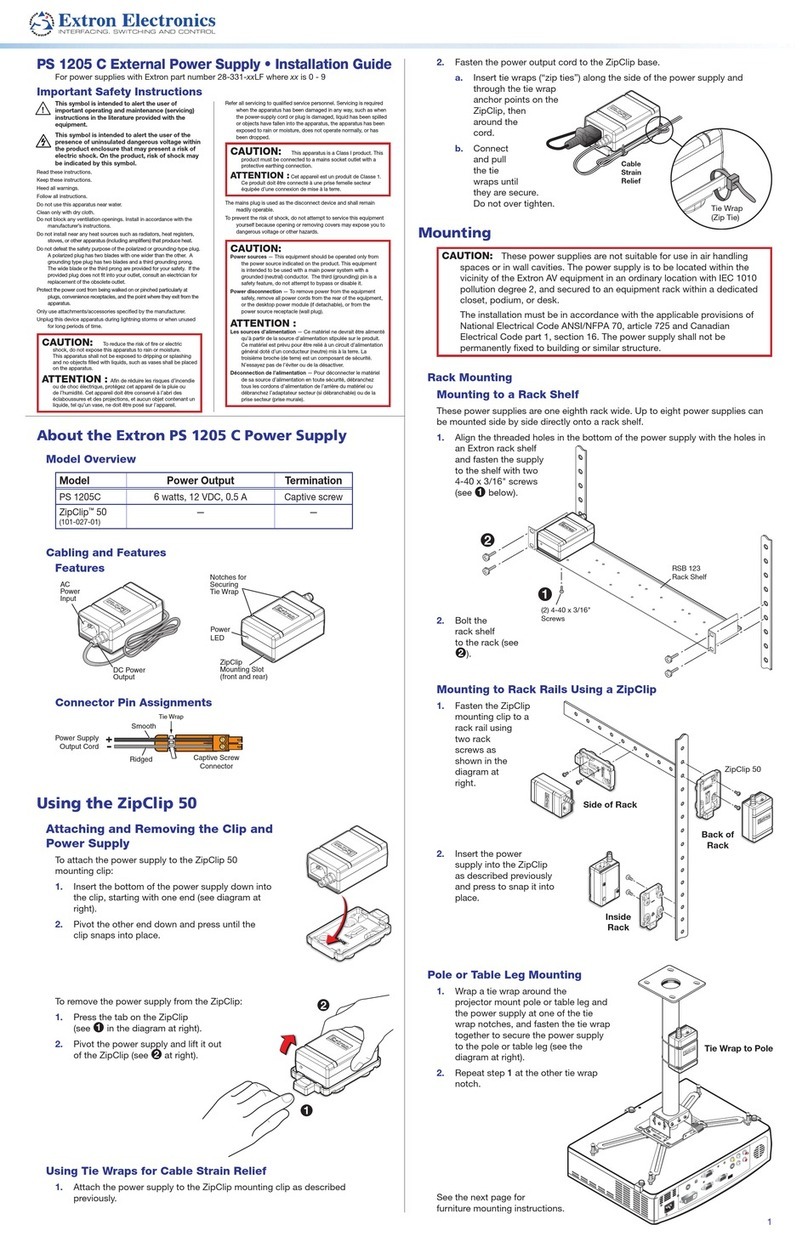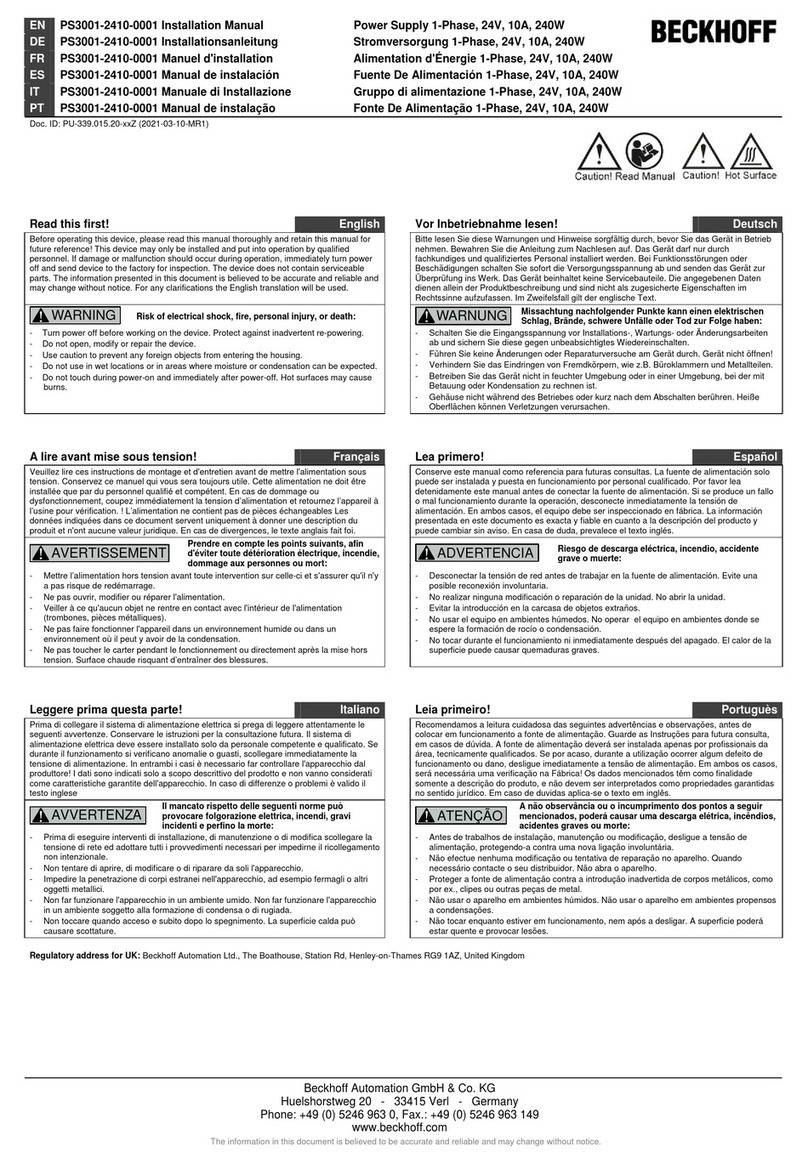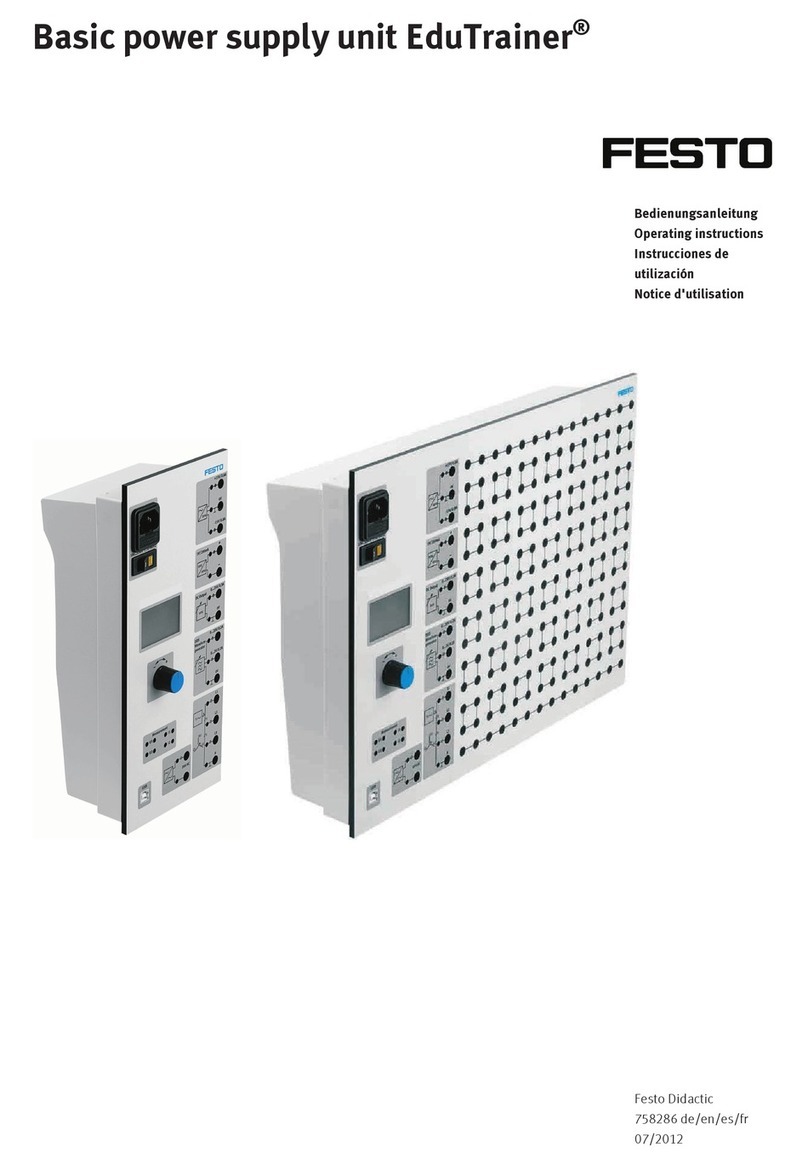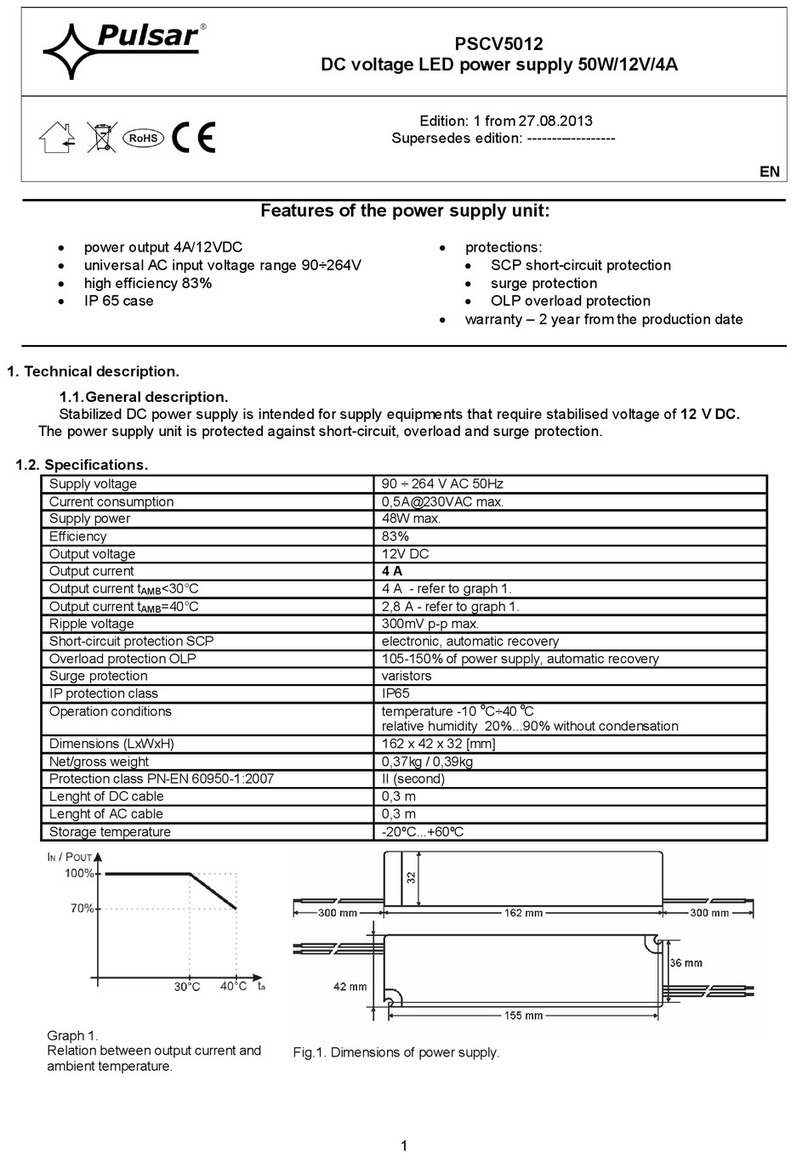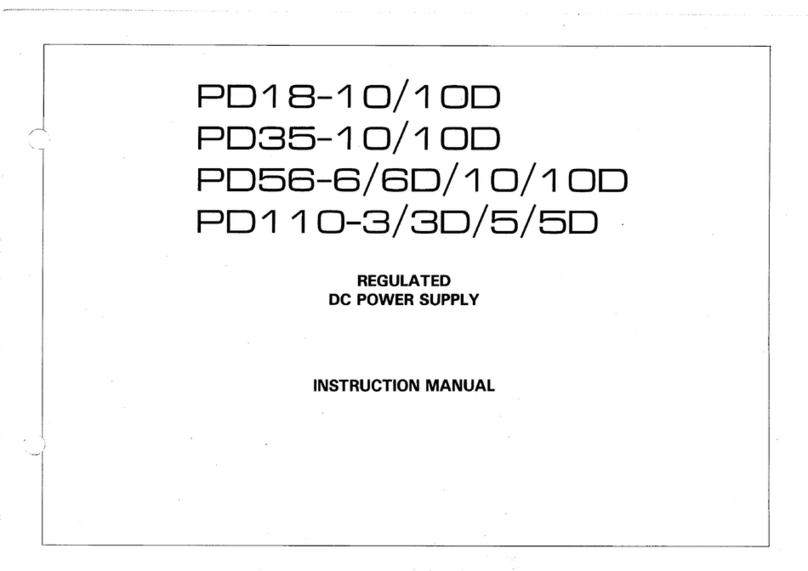FEAS LDR90 User manual

3. Montage
Das LDR kann direkt an DIN-Hutschiene montiert werden, oder an
die Wand geschraubt werden. Beachten Sie dazu die Hinweise.
ACHTUNG! Zur besseren Wärmeabfuhr sollte das Gerät einen
Freiraum von 15mm haben.
3. Installation
The LDR can be mounted on rail, or at the wall. Take notice of the
mounting alternatives attached.
CAUTION! For improved heat dissipation, the device
should have a minimum free space of 15 mm.
4. Elektrischer Anschluss
Das Gerät laut Anschluss-Schema unten anschließen. Hierbei un-
bedingt die allgemeinen Sicherheitsvorschriften beachten. Unsach-
gemäßer Anschluss kann zu einem Defekt des Gerätes führen.
4. Electrical connection
Take care of a correct electrical connection. Take the wiring diagram
at the bottom of this side as help. Inappropriate connection can
cause a defect of the device.
Betriebsanleitung
Bitte sorgfältig beachten!
Operating instructions
Please observe carefully!
LDR90
Verbraucher (z.B. Schütze, Motoren, Magnetventile, etc.)
die nicht ordnungsgemäß nach den relevanten
Richtlinien entstört sind (z.B. Varistoren, RC-Glieder, etc),
können zur Störung bzw. Zerstörung des Netzgerätes
führen.
Consumers (e.g. contactors, motors, solenoid valves
etc.) which have not been correctly interference-
suppressed in accordance to the relevant guidelines
(e.g. varistors, RC elements, etc.) may cause power
supply regulation to malfunction.
- konform
LDR9012, LDR9024
Für die Modelle: Complementing the:
GmbH
Postfach 1521
D - 22905 AHRENSBURG
Telefon: 04102 - 42082
Telefax: 04102 - 40930
www.feas.de
©2012
®
Stand / as at: 30.03.2012
!
2. Funktionsweise
Das LDR ist ein Akku-Modul zur Überbrückung von Netzausfällen im
DC-Versorgungsnetz. Die Versorgungsdauer hängt von der Größe
des Belastungsstrom der Verbraucher ab. Die Kühlung erfolgt über
Luftkonvektion.
2. Mode of operation
The LDR is a accu-modul to buffer the DC-circuit in case of power
blackouts. The supply duration depends on the magnitude of the
load-current of the consumers. The cooling of the device takes place
via air convection.
1. Allgemeine Sicherheitsvorschriften
Beim Umgang mit Produkten, die mit elektrischen Spannungen in Berührung kommen,
müssen die gültigen VDE / IEC / EN Vorschriften beachtet werden. Besonders sei auf
folgende Vorschriften hingewiesen: VDE 0100, VDE 0550 / 0551, VDE 0711, VDE 0860,
IEC 664, IEC 742, IEC 570, IEC 65
Bei Nichtbeachtung der Bedienungsanleitung oder der Anschlußvorschrift, z.B. bei
Vertauschen der Anschlußklemmen, kann das Gerät oder die Anlage beschädigt werden
und der Betreiber verliert seinen möglichen Haftungsanspruch.
Werkzeuge dürfen an Geräten, Bauteilen oder Baugruppen nur benutzt werden, wenn
sichergestellt ist, dass die Geräte von der Versorgungs-spannung getrennt sind und
interne elektrische Bauteile entladen sind.
Vor dem Öffnen des Gerätes den Netzstecker ziehen und sicherstellen, dass das Gerät
spannungslos ist und bleibt. Bauteile, Baugruppen oder Geräte dürfen nur in Betrieb
genommen werden, wenn sie vorher in ein berührungssicheres Gehäuse eingebaut
wurden. Während des Einbaus müssen sie stromlos sein.
Spannungsführende Kabel oder Leitungen mit denen das Gerät, das Bauteil oder die
Baugruppe verbunden sind müssen stets auf Isolationsfehler oder Bruchstellen
untersucht werden. Bei Feststellen eines Fehlers in der Zuleitung muß das Gerät
unverzüglich aus dem Verkehr genommen werden, bis die defekte Leitungen
ausgewechselt worden sind.
Der Anwender hat dafür Sorge zu tragen, dass die angegebenen Gerätedaten nicht
überschritten werden.
Wenn aus den vorgelegten Beschreibungen für den Anwender oder Erwerber nicht
eindeutig hervorgeht, welche Kennwerte für ein Gerät oder Bauteil gelten, so muss stets
ein Fachmann um Auskunft ersucht werden.
Im übrigen unterliegt die Einhaltung von Bau- und Sicherheitsvorschriften aller Art (VDE,
TÜV, Berufsgenossenschaften ) dem Anwender / Käufer.
1.General safety rules
When working with products which are in contact to dangerous electrical voltages,
attention must be payed to the relevant valid VDE / IEC / EN regulations. Especialy
with refrence to the following rules:
VDE 0100, VDE 0550 / 0551, VDE 0711, VDE 0860, IEC 664, IEC 742, IEC 570,
IEC 65
In case of non-observance of this instructions the unit or other equipment might be
damaged and no warranty or liability could be accepted.
When it is necessary to use tools on the device components parts or subassemblies
make sure that the power is disconnected from the device and all capacities are
discharged.
Before opening the equipment disconnect the power cord and make sure that the
contacts are not energized. It is only allowed to take components parts,
subassemblies or device into operation if they are mounted in an insulated housing.
During the installation all devices have to be disconnected from power sources.
Power cords and leads which are connected to the device, components or
subassemblies have to be inspected for damaged insulation. If a failure is detected
the device or the subassembly has to be put out of service at once. It is not allowed
to take the device or the subassembly into operation before replacing the damaged
power cord.
It is up to the user’s responsibility that the specification limits of the device are not
exceeded.
If the user is not fully able to relate the technical guidelines, a technical adviser has
to be asked for information.
The observance of construction requirements and safety rules (VDE, IEC,
employers liability insurenance i.e.) is subject to the user/customer.
Für den ordnungsgemäßen Betrieb des Gerätes ist ein
Überspannungsschutz nach VDE0185-4 / EN62305-4,
eine Vorsicherung, gemäß Tabelle, und optional ein
Netzfilter vorzusehen.
For proper operation of the device provide an
overvoltage protection, according VDE0185-4 /
EN62305-4, an input fuse as shown in table and
optionally a line filter.
Zum erreichen der maximalen Ladekapazität ist es zwingend
erforderlich:
1)Bei der ersten Inbetriebnahme des Ladereglers die Akkus
mindestens 24 Stunden zu laden.
2)Die Akkus durch mindestens 3 volle Lade- und Entladezyklen
bei gleichzeitiger Stromentnahme (ca 50%) zu konditionieren.
Wenn die oben beschriebene Prozedur nicht durchgeführt wird,
kann es vorkommen, dass schon nach wenigen Minuten die
LED “Akku voll” leuchtet, obwohl der Akku noch nicht
vollständig geladen ist.
For reaching the optimal capacity it is strongly essential:
1)With the first beginning of operation to charge the accus for
min. 24 hours.
2)To charge and discharge the accus minimum three times, in
order to condition the accus. This procedure should be made
with ca. 50% output load.
If the procedure mentioned above are not enforced, it is
possible that the LED “Akku voll” is switching on even if the
accu is not fully charged.
AC-Eingang
AC-Input
DC-Ausgang
DC-output
+
-
L1
L2
Relais 1 - Schließer
(siehe Punkt 4.1 - Fernüberwachung)
Relay 1 -
(see point 4.1 - Remote monitoring)
normally open contact
320 - 550 VAC
oder / or
450 - 780 VDC
1
42
SHUT DOWN
Anschlußbeispiel / Wiring Example
PE
Klemme SHUT DOWN zur manuellen
Abschaltung im Pufferbetrieb
(siehe Punkt 4.3 - Fernüberwachung)
Terminal SHUT DOWN for manual
shut down in buffering mode
(See point 4.3 - Remote monitoring)
Relais 2 -
Relay 2 - normally open contact
(See point 4.2 - Remote monitoring)
Schließer
(siehe Punkt 4.2 - Fernüberwachung)
L3
Bohrschablone siehe
Bedienungsanleitung auf
www.feas.de
Drill pattern is showing in the
operation instruction on
www.feas.de
1
3
Kontaktbelastung der Relais:
- max. Schaltleistung 240W oder 2000VA
- max. Schaltstrom 8,0Amp.
- max. Schaltspannung 150VDC oder 400VAC
Contact-load of the relays:
- max. switched power 240W or 2000VA
- max. switched current 8,0Amp.
- max. switched voltage 150VDC or 400VAC
Relay : Normally open contact means in this case, that the relay contacts are
open if the nominal input voltage (all three phases) is OK.
Relais : Schließer bedeutet, das im normalen Betriebszustand des Gerätes,
bei vorhandener nominaler Eingangsspannung (alle drei Phasen),
die Relaiskontakte geöffnet sind.
5. Fernüberwachung
Um eine Fernüberwachung des Akkupacks zu ermög-
lichen, sind 2 Relais eingebaut und auf Klemmen geführt.
Belastbarkeit siehe Zeichnung unten.
4.1 Relais 1 (Klemmen 1 / 2) - Schließer
Bei vorhandener Eingangsspannung (alle 3 Phasen)
sind die Kontakte 1 und 2 geöffnet. Sobald eine
oder mehrere Phasen ausfallen, Schließt das Relais
und es kann die Statusmeldung “Phase ausgefallen”
entnommen werden. Zusätzlich erlischt die
entsprechende LED.
4.2 Relais 2 (Klemmen 3 / 4) - Schließer
Sinkt die Ausgangsspannung, im Pufferbetrieb, unter
eine bestimmte Grenze, (22,0V)schließt das Relais
und es kann die Statusmeldung “Ausgangsspannung
wird gleich ab geschaltet” entnommen werden. Der
Abschaltzeitpunkt des LDR, ist abhängig von der
Stromentnahme. Sinkt die Ausgangsspannung unter
einen Wert von 20,0Volt, wird die Ausgangsspannung
automatisch abgeschaltet, um die Akku’s vor
“Tiefenentladung” zu schützen.
.
.
5. Remote monitoring
In order to enable a remote monitoring of the storage
battery, 2 relays are built in and are routed to terminals.
Maximum load of the relays are shown in the drawing
below.
4.1 Relay 1 (Terminal 1 / 2) - normally open contact
In the case of the presence of input voltage
(all 3 phases) , Contacts 1 and 2 are open. As soon
as one or more phases switched off, the relay closes
and “Phase is lost” can be seen on the status signal.
Additional the corresponding LED expires.
4.2 Relay 2 (Terminal 3 / 4) - normally open contact
If the output voltage sinks below a certain limit (22,0V),
during the buffer mode, the relay contact closes and
the status signal “Output voltage will be disconnected”
can be seen.The switch-off point of the LDR is
dependent on the current consumption. If the output
sinks below a value of 20,0Volt, the output voltage is
disconnected automatically in order to protect the
storage battery against “Deep Discharge”.
.
.

Stand / as at: 10.04.2012
© 2012
Postfach 1521
D - 22905 Ahrensburg
Telefon: +49 4102 42082
Fax: +49 4102 40930
E-Mail: [email protected]
Internet: www.feas.de
Bedeutung der LED-Anzeige 0-100% / Meaning of the LED-Display 0-100%
= LED an / on = LED aus / off = LED blinkt / flashing gn = grün / green rd = rot / red
Status
LED
Akkuspannung > 25V / Accu voltage > 25V
2. Akkustatus / Accu status
gn
Akkuspannung > 24V / Accu voltage > 24V
gn gn
Akkuspannung > 23V / Accu voltage > 23V
gn gn gn
gn gn
Akkuspannung > 22V / Accu voltage > 22V
rd
gn gn gn gn
Akkuspannung < 21V / Accu voltage < 21V
rd
Akkuspannung > 21V / Accu voltage > 21V
rd
rd
Status
LED
1. Pufferzeitbegrenzung / Buffer time limiting
Pufferzeit 0 - 59 Sekunden / buffering time seconds0 - 59
rd
rd
rd
gn
gn
Pufferzeit 2:00 - 2:59 Minuten / buffering time 2:00 - 2:59 minutes
Pufferzeit 4:00 - 4:59 Minuten / buffering time 4:00 - 4:59 minutes
Pufferzeit 10 - 19 Minuten / buffering time 10 - 19 minutes
Pufferzeit 30 - 39 Minuten / buffering time 30 - 39 minutes
Pufferzeit 1:00 - 1:59 Minuten / buffering time 1:00 - 1:59 minutes
rd
Pufferzeit 3:00 - 3:59 Minuten / buffering time 3:00 - 3:59 minutes
Pufferzeit 5:00 - 5:59 Minuten / buffering time 5:00 - 5:59 minutes
gn Pufferzeit 20 - 29 Minuten / buffering time 20 - 29 minutes
rd
gn Pufferzeit 40 - 49 Minuten / buffering time 40 - 49 minutes
gn Pufferzeit > 50 Minuten (Begrenzung aus) / buffering time > 50 minutes (limiter off)
5. Fernüberwachung
4.3 Manuelle Abschaltung im Pufferbetrieb
(Klemme SHUT DOWN)
Im Pufferbetrieb, wenn keine Eingangsspannung vor-
handen ist, kann das LDR manuell abgeschaltet werden.
Zum Abschalten wird die Klemme SHUT DOWN kurz auf
“Minus” gelegt, worauf das Gerät abschaltet und den Akku
vom Netz trennt. Beim nächsten Anlegen der Netzspannung
kommt das Gerät wieder in den “Arbeitszustand”
.5. Remote monitoring
4.3 Manual shut down in buffering mode
(Terminal SHUT DOWN)
During the buffer mode it’s possible to shut down the
LDR manually. To shut down the device put the
terminal SHUT DOWN shortly to “minus”. In that
case the LDR switched off and cut off the accu from
the line. It comes back to normal operation with the
next line voltage connection.
.
6. LED’s
- Die grünen LEDs (L1, L2, L3) signalisieren die vorhandenen
Phasen der Eingangsspannung(siehe 4.1 Fernüberwachung).
- Die LED (Temperatur) signalisiert mit gelb eine zu hohe
Temperatur im Gerät, der Akku wird nicht geladen.
Mit rot wird im Puffermodus die Abschaltwarnung signalisiert
(siehe 4.2 Fernüberwachung).
- Die LED (Laden) signalisiert bei gelb, das der Akku geladen
wird, bei grün das der Akku voll ist.
- Das Potentiometer (Bt ) dient zur Einstellung der Pufferzeit-
adj.
begrenzung.
- Die LEDs (1 bis 5) zeigen im normalen Betrieb die höhe der
Pufferzeitbegrenzung an.
Im Pufferbetrieb zeigen die LEDs den Zustand des Akkus an.
Details siehe Tabellen auf der Vorderseite.
6.LED’s
-The green LEDs (L1, L2, L3) signals the connected phases
of the input voltage (see 4.1 Remote monitoring).
-The LED (Temperatur) signals in yellow a temperature in the
device that is too high, the accu won’t be charged.
In red the LED signals the shut of warning of the LDR during
the buffer mode (see 4.2 Remote monitoring).
-The LED (Laden) signals that the storage battery will be
charged, in yellow. If the LED lights green, the storage
battery is fully loaded.
-The potentiometer (Bt ) is for limiting the buffer time.
adj.
-The LED (1 to 5) signals the adjusted limit for the buffer time,
in normal operation mode.
In buffering mode the LEDs signals the status of the storage
battery, details see tables as shown on the front page.
7. Technische Daten 7. Technical Data
320 - 550VAC
450Volt - 780VDC
0 - 400Hz
< 25,0 A bei 550VAC
ca. 1.2 INENN
< 200mV bei Laständerung 10...90%
< 50mV bei Netzspannungsänderung ±10%
< 10 mSek. bei Laständerung 10...90%
100%
- 20°C bis +50°C
ab 40°C
-30°C...+65°C
natürliche Konvektion
empfohlener Freiraum je 15mm
bei 400V - 2,0A träge je Phase
AC
nicht erforderlich, da kurzschlussfest
im Gerät integriert
>380.000 h ohne Akku
5 kV gemäß VDE 0551
AC
Eingang / Ausgang 3,75 kVAC
nach VDE 0806 / IEC 380
gemäß VDE 0871 B, EN 55022/B
Klasse 1, mit PE Anschluss (EN 60950)
95% relative Feuchte im Jahresdurchschnitt
Betauung möglich - tropentauglich
IP 65
IP 20 (BGV A3)
>30g bei 33Hz in X,Y und Z,
nach IEC 60068-2-27 ohne Akku
Wandmontage aufschraubbar
siehe Gehäuseaufdruck des Gerätes
< 50mVss
bei 400V max. 0,85A je Phase
AC
Transientenüberspannungsschutz Varistor
PELV (EN60204), SELV (EN 60950)
siehe Gehäuseaufdruck des Gerätes
Einschaltstromstoß
Ausgangsgrößen
Ausgangsspannung U
Strombegrenzung
Regelgrößen (Netzteil)
Regelabweichung Last
Regelabweichung Netz
Regelzeit
Betriebsdaten
Einschaltdauer (ED)
Arbeitstemperatur
Leistungsabweichung bei Temp.
Lagertemperaturbereich
Kühlung
Schutzeinrichtungen
Vorsicherung LDR9024
Ausgangssicherung
Überlastschutz
MTBF
Sicherheitsdaten
Prüfspannung Trafo
Hochspannungsfestigkeit
Funkenentstörgrad
Schutzklasse
Umgebungsfeuchte
Schutzart Gehäuse
Schutzart Klemmen
Rüttelfestigkeit
Angewandte Bauvorschriften
Nenn
Eingangswechselspannung
Eingangsgleichspannung
Eingangsgrößen
Restwelligkeit (20MHz)
gemäß VDE
IEC
EN
CSA / UL
Befestigung
Mechanik
Stromaufnahme bei Nennlast LDR9024
Schutzbeschaltung
Schutzkleinspannung
Ausgangsstrom INenn
VDE 0100,0110,0113,0140-1,0551,0160/W2,0806,
IEC 60950,IEC61000-6-1-2-3-4,IEC60068-2-3
EN60950, , ,ENEN61000-6-1 EN61000-6-2 61140
CSA-C 22.2 / UL60950, UL508, UL1950
EN61000-6-3,EN61000-6-4,EN50178,EN55022
EN55011,EN61000-3-2,EN61000-3-3,EN50204
EN60204,EN60529,EN61000-4-2-3-4-5-6-8-11
EN60068-1,EN60068-2-1-2-3-6-27-30
EN45501,EN50021,EN61558-2-17
IEC 60068-2-11-52,IEC 60529,IEC 380
320 - 550V
AC
450V - 780V
DC DC
0 - 400Hz
< 25,0 A at 550VAC
< 200mV 10...90%with load variation
< 50mV with supply variation ±10%
< 10 mSek. 10...90%with load variation
100%
- 20°C to +50°C
from 40°C
-30°C...+65°C
selfcooling
recommended respective distance 15mm each
at 400V - 2.0A delayed each phase
AC
not necessary, cont. short circuit proof
integrated into the device
>380,000 h without storage battery
5 kV in accordance to VDE 0551
AC
Primary circuit - secondary circuit 3,75 kVAC
acc. to VDE 0806 / IEC 380
in acc. to VDE 0871 B, EN 55022/B
Class 1, with PE connection (EN 60950)
95% relative humidity, yearly average dewing
allowed for use in tropical ambient
IP 65
IP 20 (BGV A3)
>30g at 33Hz in X,Y and Z,
acc. to IEC 60068-2-27 without storage battery
wallmounting with screws
see face plate
< 50mVpp
at 400V max. 0,85A each phase
AC
Transient voltage suppressor Varistor
PELV (EN60204), SELV (EN 60950)
see face plate
Input current peak
Output data
Output voltage U
Current limiting
Control data (DC power supply)
Control deviation load
Control deviation supply
Control time
Operating data
Duty circle
Operating temperature range
Derating
Storage temperature range
Cooling
Safety devices
Fuse for input LDR9024
Fuse for output
Overload protection
MTBF
Safety data
Test voltage transformer
High voltage resistance
Degree of EMI suppresion
Protection class
Ambient humidity
Protective class enclosure
Protective class terminals
Vibration proof
Applied construction regulations
Nominal
Input voltage AC
Inputvoltage DC
Input data
Residual ripple (20MHz)
according to VDE
IEC
EN
CSA / UL
Mounting
Mechanics
Input current at nominal load LDR9024
Protective circuit
Extra low safety potential
Output current INominal
VDE 0100,0110,0113,0140-1,0551,0160/W2,0806,
IEC 60950,IEC61000-6-1-2-3-4,IEC60068-2-3
EN60950,EN61000-6-1,EN61000-6-2,EN61140
CSA-C 22.2 / UL60950, UL508, UL1950
EN61000-6-3,EN61000-6-4,EN50178,EN55022
EN55011,EN61000-3-2,EN61000-3-3,EN50204
EN60204,EN60529,EN61000-4-2-3-4-5-6-8-11
EN60068-1,EN60068-2-1-2-3-6-27-30
EN45501,EN50021,EN61558-2-17
IEC 60068-2-11-52,IEC 60529,IEC 380
approx. 1.2 INOMINAL
bei 400V max. 0,85A je Phase
AC
Stromaufnahme bei Nennlast LDR9012 Input current at nominal load LDR9012 at 400V max. 0,85A each phase
AC
bei 400V - 2,0A träge je Phase
AC
Vorsicherung LDR9012
at 400V - 2.0A delayed each phase
AC
Fuse for input LDR9012
Accu 2
Accu 1
+
-
+
Batteriewechsel / Battery replacment
24V-Version12V-Version
Akku 2
Akku 1
+
-
+
Remove here the
screws M4 with
Inbus-key(SW2,5)!
Hier Inbusschrauben
M4 mit Inbusschlüssel
(SW2,5) lösen!
8. Batteriewechsel
Schritt 1: Eingangsspannung ausschalten.
Schritt 2: Gerät auf den Kopf stellen.
Schritt 3: Die 7 Inbusschrauben (M4) von der Bodenlatte
abschrauben.
Schritt 4: Akkus herausnehmen und die Kabel von den
Kontakten abziehen.
Schritt 5: Neue Akkus an die Kabel anschließen (Achtung
auf die Polarität achten! Rote Kabel zum Plus-
Pol, Blaue Kabel zum Minus-Pol des Akkus)
Schritt 6: Akkus in den Batterieraum schieben.
Schritt 7: Bodenplatte wieder aufschrauben.
Schritt 8: Die alten Akkus ordnungsgemäß und umwelt-
gerecht entsorgen!
8.Battery replacment
Step 1: Switch off input voltage.
Step 2: Place device on its upper surface.
Step 3: Screw off the 7 Allen screws (M4) from the
base plate.
Step 4: Remove storage batteries and pull the cables
from the contacts.
Step 5: Connect new storage batteries to the cables
(Note polarity! Red cable to the positive terminal
of the storage battery).
Step 6: Slide storage batteries into the battery compartment.
Step 7: Screw base plate back again.
Step 8: Dispose of the old storage batteries properly and
environmentally safely!
Eine Verpolung der Akkus beim Einsetzen führt unweigerlich
zur Zerstörung des Gerätes und ist nicht reparabel und führt
zum erlöschen der Gewährleitungsansprüche.
Reverse polarity of battery causes the damage of the device
and is not repairable.
This leads to termination of warranty.
-
-

HRW3.3.230.20-400
Art.Nr.: 652316
Halbleiterwendeschütz
Kontaktloses Schalten für lange Lebensdauer
Im Gerät integrierter Varistorschutz
Integrierter Übertemperaturschutz
Phasenausfallerkennung auch bei laufendem
Verbraucher
Relais-Meldung von Übertemperatur und Phasenausfall
Besonders geeignet für den Einsatz in rauer Umgebung
LED-Betriebsanzeige
Kontakte aus Edelmetall für hohe Schaltleistung
Einfache Montage auf DIN-Schiene
Technische Daten:
Steuerspannungsbereich: 75-270 VAC / 60-300 VDC
Lastspannungsbereich: 48 - 660 VAC
Dauerlaststrom: 3 x 20 A
Max. Überlaststrom: 300 A
Kanalzahl: 3
Arbeitstemperatur: -40°C / +80°C
Montage: auf Hutschiene nach DIN 46277
Abmaße (BxHxT): 107,0 x 118,0 x 118,0 mm
RZM122-80M
Art.Nr.: 52007
Redundanzmodul
Erhöhen Sie Ihre Anlagensicherheit nach (n+1) oder (1+1) Prinzip
LED Statusanzeige
Relaismeldung für Netzausfall und Übertemperatur
Einstellbare Fehlerwertgrenze
Integrierter Kühlkörper
Thermischer Überlastschutz
Verpolungsschutz
Einfache Montage auf DIN-Schiene
EMV und Niederspannungsrichtlinienkonform
Sicherheit nach VDE, EN, UL, CSA
Technische Daten:
Spannungsbereich: 40-120 VDC
Eingangsstrom: 2x 40 A
Ausgangsstrom: 1x 80 A
Arbeitstemperatur: -40°C / +80°C
Montage: auf Hutschiene nach DIN 46277
Abmaße (BxHxT): 73,0 x 118,0 x 118,0
Technische Daten:
Bemessungsspannung: 250 VAC
Bemessungsstrom: 8,0 A
Induktivität: 2 x 2,7mH + 2 x 2,7mH
Kapazität: 3 x 0,47µF + 4 x 22nF
Arbeitstemperatur: -50°C bis +85°C
Abmaße (BxHxT): 64,0 x 100,0 x 120,0 mm
Gewicht: 1,10 kg
Montage: auf Hutschiene nach DIN 46277 und
Wandmontage
Hohe Einfügungsdämpfung über einen großen Frequenzbereich
Optimiert gegen asymmetrische Störungen
Verbesserte Filterleistung durch 2-stufigen Aufbau
Tropentauglich durch Gießharzvollverguss
Sicherheit nach VDE, EN, UL CSA
NFK855-8A22
Art.Nr.: 51085
Entstörfilter
Werbung
12,0
13
1 CA 0,5 CA 0,2 CA 0,1 CA
11,5
11,0
10,5
10,0
9,5 0 30 60
1h
90 120
2h
150 180
3h
210 240
4h
270 300
5h
330 360
6h
390 420
7h
450 480
8h
510 540
9h
570 600
10h
630 660
11h
Spannung / Voltage U (V) è
Entladezeit / Discharging period t (min) è
Entladekennlinien bei 20°C - Discharge current diagram at 20°C
LDR9012
24,0
26,0
1 CA 0,5 CA 0,2 CA 0,1 CA
23,0
22,0
21,0
20,0
19,0 030 60
1h
90 120
2h
150 180
3h
210 240
4h
270 300
5h
330 360
6h
390 420
7h
450 480
8h
510 540
9h
570 600
10h
630 660
11h
Spannung / Voltage U (V) è
Entladezeit / Discharging period t (min) è
Entladekennlinien bei 20°C - Discharge current diagram at 20°C
LDR9024
9. Betriebshinweise
a)Um die eingebauten Akkus vor unzulässiger Erwärmung zu
schützen, ist das LDR mit einem thermischen Ladeschutz
ausgerüstet.
Dieser Ladeschutz bewirkt, dass das LDR abschaltet und der
Ausgang durch die Akkus versorgt wird.
Aus diesem Grunde bitte für ausreichende Kühlung sorgen!
b)Sinkt die Ausgangsspannung unter einen Wert von 19,0V (24V-
Version) bzw. 9,5V (12V-Version) wird die Ausgangsspannung
automatisch abgeschaltet, um die Akku’s vor “Tiefenentladung” zu
schützen.
c)Bei dauernder Überlast von ca. 14A blinken die LED “Akku voll”
und LED “Laden” abwechselnd.
9. Hints for operation
a)In order to protect the built-in storage batteries against
inadmissible heating, the LDR is equipped with a thermal
charge protection.
This charge protection has the effect that the LDR turns off and
the Load will be supplied by internal accus.
For this reason please provide for sufficient cooling!
b)If the output sinks below a value of 19,0V (24V Version) or 9,5V
(12V Version) the output voltage is disconnected automatically in
order to protect the storage battery against “Deep Discharge”.
c)In the case of contiuous overload of appr. 14A the LED “Akku voll”
and LED “Charge” are flashing alternately.

M= 1:1
Bohrschablone - Drill-Pattern
LDR90
230 mm
151,5
9,5 9,5
25,0
25,0
Geeignet für M8 Schrauben
Suitable for M8 screws
M = 1:1
Klemmen / terminals
This manual suits for next models
2
Other FEAS Power Supply manuals

